It’s a classic scene in American education: classrooms filled with students who sit in neat rows of desks as they listen to a teacher’s lecture.
Now scratch that.
Instead, imagine the classroom as a grassy park, a yurt, a school garden, a potato farm, or the Idaho wilderness. And instead of sitting and listening, the students are climbing trees, singing songs, skiing, backpacking, drawing, exploring, or harvesting food.
For more and more Idaho students, the second version of a classroom is their reality.
Environmental education and outdoor adventures are becoming pillars at more schools across the state – both private and public – as educators work to expand opportunities for students to learn outside.
Proponents of outdoor education say it makes learning fun, memorable, and meaningful. Plus, it prepares students to confront the challenges of climate change and make educated decisions as adults.
And parents are seeking out that kind of learning for their kids. Their enthusiasm is partly a rebellion against pandemic-era increases in screen time and remote learning – parents want their kids to log off the computer and head outside.
A new environmental learning grant program, up-and-coming outdoor-focused schools, and outdoor classrooms are just some of the new initiatives being implemented across the state to get more kids thinking outside the box – literally.
Hailey’s The Sage School aims to instill a sense of Idaho pride in students
Keeping kids in classrooms at all times is a disservice, according to Chris McAvoy, the cofounder and assistant head of school for The Sage School, a private, tuition-based school that serves about 95 students in grades 6-12.
“If we don’t teach them outside of the school we teach them that the outdoors isn’t important,” McAvoy said. “By teaching them constantly inside, we’re actually devaluing our relationships with the natural world.”
Students at The Sage School spend five weeks in the field each school year, and the places they travel relate to their studies.
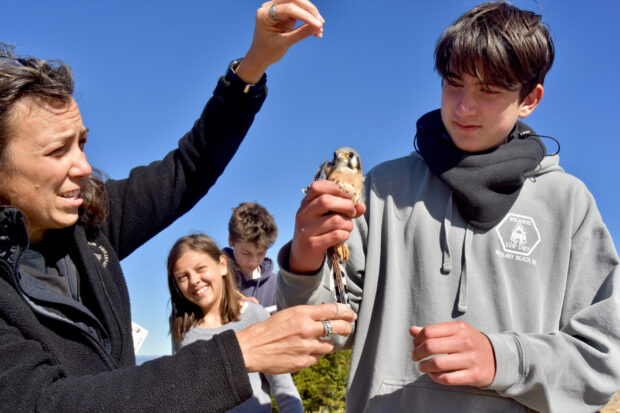
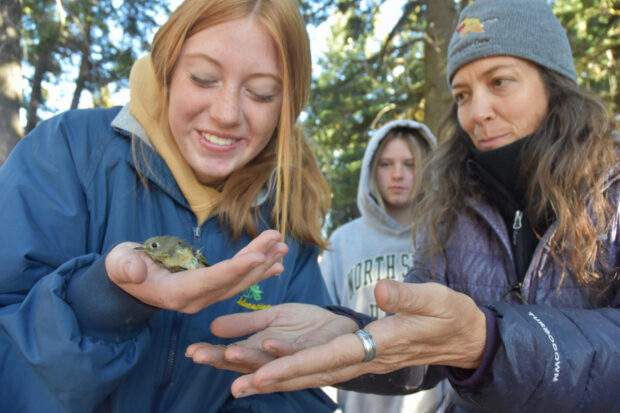
For example, sixth and seventh graders spend two weeks traveling the Oregon Trail. Other students travel through southern Idaho and visit massive dairies and small organic farms to understand how people relate to the land, animals, and crops. Others might study wilderness and go backpacking or study human rights and social change by visiting San Francisco.
McAvoy said he wants students to graduate with a sense of place from growing up in the west and in Idaho.
“By teaching them constantly inside, we’re actually devaluing our relationships with the natural world.” — Chris McAvoy, cofounder and assistant head of The Sage School
It’s a place-based program, meaning students learn about concepts that can be tied in locally. That often means having local guest speakers or taking trips into the community.
The school wants learning to be experiential. Students get a different sense of the wilderness by camping in it than they do by reading about it, and a different sense of salmon by netting them in a river than by seeing them on the computer.
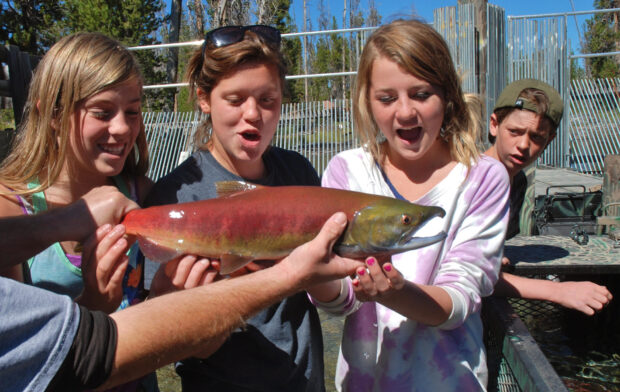
“Where the environment is struggling in so many ways, we want to help kids connect more deeply and be able to understand how and why protecting the natural world is vitally important,” McAvoy said.
He acknowledged that teachers in a traditional public school might have a harder time getting kids outdoors due to the logistics, cost, transportation needs, or paperwork.
“A lot of teachers might just say forget it, it’s not worth it,” he said.
But there are ways to get kids outside that are easier – like building a garden or greenhouse on school grounds or walking with kids to a local park.
And a charter school in Pocatello has been doing just that.
Local parks and school grounds provide plenty of opportunities for environmental learning
On a recent sunny day, a Pocatello park became a temporary classroom for a group of first- and second-graders, who used it to play a get-to-know-you game and listen to a story.
Their school, Pocatello Community Charter School, is just feet away from Centennial Park, the Portneuf River, and the greenway trail system. They make use of those local resources frequently.
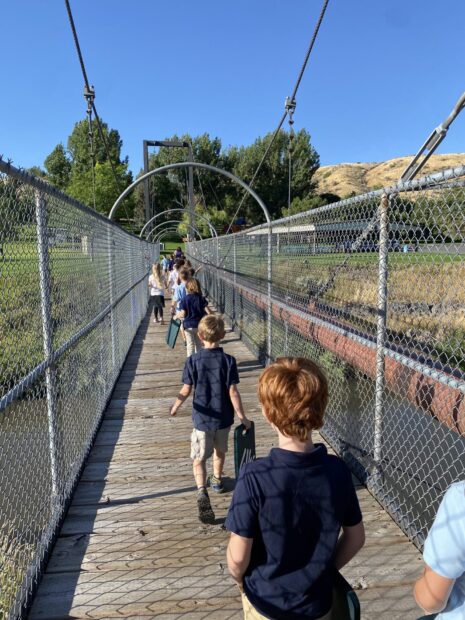
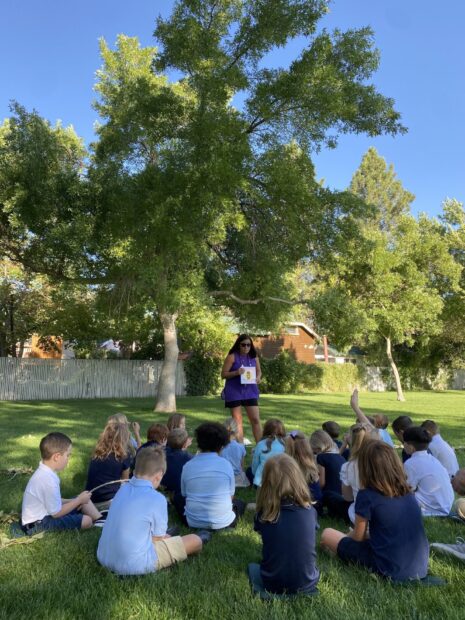
Back on campus, one class came outside to say the pledge of allegiance and two others met outside for some collaborative learning. A fourth class was in the school’s garden – maintained by local master gardeners – making observations and sketching what they found.
It’s just a typical day at the K-8 charter school.
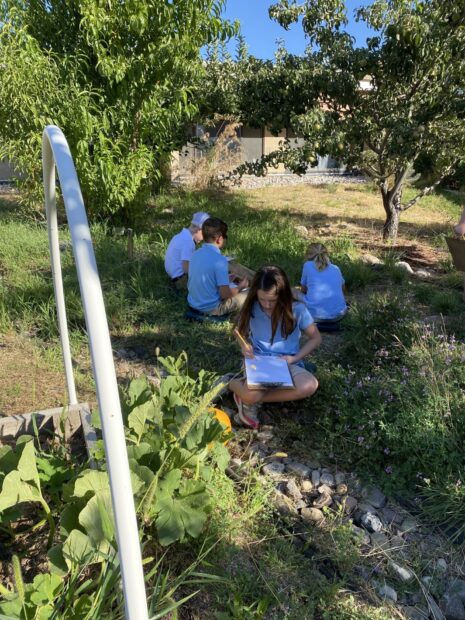
Getting outside appeals to different students and strengths, Mike Mendive, the school’s director, said. Plus, it keeps things interesting.
“It gets to be a drag when students are in the same class all day everyday,” Mendive said.
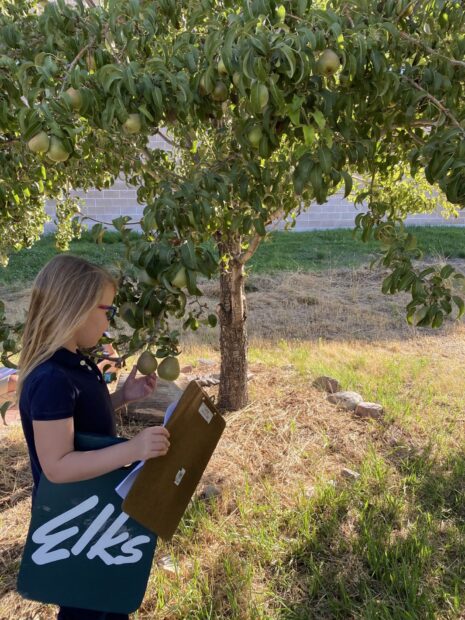
The school also prioritizes educational field trips and takes students to the University of Idaho’s McCall Outdoor Science School, to Yellowstone National Park, and to local potato farms. The PTO, local businesses, and parent donations help fund the trips.
“We want to provide students with experiences that create memories that last a lifetime,” Mendive said. “If it’s not meaningful or practical or relevant to your daily life, you don’t remember it.”
That experiential, field learning means students can speak intelligibly about water turbidity after practicing water quality testing or about pikas after a trip to the Tetons.
In addition to field learning, outdoor adventure is also a key component of the school’s curriculum.
Every year, every student camps overnight, rock climbs, and crosses snow. And that’s not to mention the opportunities for mountain biking, river floating, and even rollerblading that the school offers.
“It instills self-confidence so students start realizing they can do more than they think they can,” Travis Kumm, the school’s P.E. teacher and adventure coordinator said.
Mendive believes the confidence built up by rappelling or backpacking translates to learning. Dividing fractions might seem impossible, but students will have already learned to persevere in difficult tasks – so they won’t disengage.
The school, founded in 1999, has always had a focus on outdoor learning and is continuing to expand its opportunities for students. This fall, it plans to build an outdoor classroom, which will consist of a pavilion with drop-down whiteboards and access to technology (covid relief funds will pay for it).
And that’s an addition to a campus that already boasts a synthetic turf, a solar panel, a windmill, and a dirt pump track for bikers.
And more schools in Idaho are starting to incorporate an outdoor-learning model.
A brand new charter school is setting up shop at the base of a ski resort
On Sept. 6, the Mountain Community School will hold its first-ever day of classes. The new charter, which serves K-8 students, will operate out of yurts and outbuildings just feet away from the chairlift at Tamarack Resort near Donnelly.
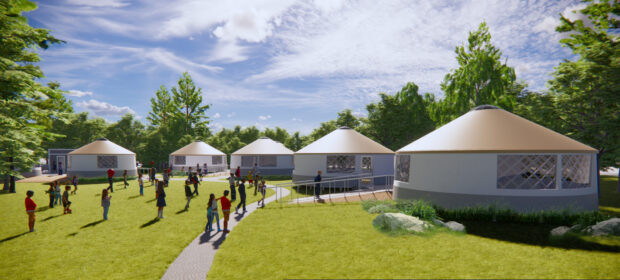
And if the students get tempted to drop their books and grab their skis or snowboards this winter, they’ll get to – at least one day a week.
On typical days, they’ll head outside a few times for brain breaks that will last 20 minutes to an hour. And their learning might take place on the mountainside, in the greater Donnelly community, or in the yurt – it just depends on the lesson. For example, MCS students might learn about mountain ecosystems and the life they support, then head out to explore Tamarack Resort.
Patrick Berg, co-founder and head of the school, said he wanted to start the school because the traditional system of learning doesn’t work for everyone.
“People of all demographics need choices in how they learn,” he said.
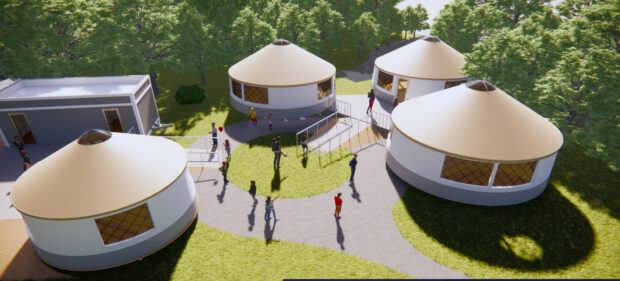
The school can have up to 115 students, and currently about 100 are enrolled. Most of the students are from the McCall, Donnelly, or Cascade areas.
A new opportunity for outdoor learning is coming to the Boise area, too.
A new all-day kindergarten program will keep kids outside all day – rain, shine, or snow
“There’s no such thing as bad weather, just bad equipment,” Erica Hermsen, founder and executive director of EverWild Forest School, said.
This year, the private school is starting up an all-day kindergarten program in Garden City that will keep kids learning outside no matter what the weather does.
Kids are expected to come prepared with the clothing they need to be outside all day, but the school also provides a gear library to help offset costs for families. Canopies, daily tea times, and a 20-foot cargo trailer that’s been converted into a warm-up space are some other antidotes to the cold.
But 80-90% of the time, the kindergarteners will be outside, where they might be climbing trees, writing with sticks in the dirt, balancing on logs, or stacking rocks. It might not seem like it, but they’re learning even during unstructured play time, Hermsen said. The lessons are less obvious but they’re there – like risk assessment, balancing and building structures, learning to write letters, or gaining confidence.
The kindergarten will also have more formal learning sessions that focus on core subjects like math, language arts, social studies, and science – but class is always held outside and lessons are place-based and draw on local resources. A history lesson might include a guest speaker from IdaHistory or a science lesson might focus on flows in the Boise River. And students are involved in the learning.
“It’s a back-and-forth dialogue instead of having a ‘sage on the stage,’” Hermsen said in a critique of lecture-based teaching.
Hermsen, a former environmental scientist, left her job to create a school that she would want for her own kids – one that prioritizes a connection to nature. In Europe, forest schools are common, and that’s where Hermsen got the idea.
The forest school started up during the pandemic and has increasingly grown since then
Hermsen moved from California to Boise and started the school in the fall of 2020.
She imagined the school would have two teachers and 24 students, but there was so much interest that they ended up with 28 teachers and 150 students that first year. She knew the pandemic was part of the reason for the interest.
“People were really looking for an alternative to kids being inside on screens all day doing virtual learning,” Hermsen said. “During these really hard times of Covid, nature provides such a beautiful place for people to regulate their sensory systems and find calm and peace in a disrupted world.”
At first, the school offered enrichment programs to supplement classroom learning or homeschool learning. The kindergarten program will be its first all-day offering.
“During these really hard times of Covid, nature provides such a beautiful place for people to regulate their sensory systems and find calm and peace in a disrupted world.” — Eric Hermsen, founder and executive director of EverWild Forest School
The school has also expanded its locations since 2020 and now has five – two are in Boise and Garden City, Nampa and Eagle each have one. The school is a tuition-based nonprofit and charges families on a sliding scale based on income. It is also partially funded with grants and donations.
Hermsen said people have had a hard time grasping the idea of learning that leaves the classroom behind, but she says that outdoor education positively impacts students’ physical, mental, and emotional health.
“The literature shows that learning in nature actually creates more well-rounded students who are more likely to apply to and be accepted into a four-year college,” she said. “And it helps with creating a sense of place and allowing students to feel engaged in their community and in nature.”
That would come as no surprise to directors at the University of Idaho’s McCall Outdoor Science School, which has been fostering K-12 environmental education since the early 2000s.
MOSS is seeing increased participation and wants every Idaho student to practice science outside of the classroom
The outdoors are the best co-teacher, according to Karla Eitel, Director of MOSS and the McCall field campus, located on the shores of Payette Lake. Whether it’s getting to watch birds flying, seeing how water moves, or just experiencing the seasons, nature is full of lessons.
Those lessons create what Eitel calls “sticky learning” that students won’t forget.
“Young people can see with their own eyes and experience the ecosystem,” she said. “It prompts their own questions, their sense of curiosity and wonder.”
And students who struggle to sit still in the classroom often thrive when learning outside.
Beth Kochevar, the K-12 programs director for MOSS, said the outdoors help students think outside the box about complex problems.
“It allows students to see multiple perspectives and see the correlation between themselves and the natural world and be ready to bring in those different contexts into future decision making,” Kochevar said.
MOSS provides residency-based learning where students can visit campus and stay overnight with chaperones and teachers. MOSS works with about 32 schools every year – and involvement in the program has only been growing.
This summer, enrollment in MOSS’s program doubled. They typically have around 1,000 student user days in a summer, but this year that number jumped to 2,500.
McCall’s growth during the pandemic is part of that. But people are also craving more face-to-face interaction and time outside.
“We think it’s fantastic,” Eitel said of the increased interest. “We’d love to see every student in the state of Idaho have that experience, but we love sharing that responsibility with other folks across the state.”
The Boise School District, for example, is working to create its own version of a MOSS environmental, experiential learning program.
The Boise School District is starting a new environmental learning initiative
Last school year, Misha Smith’s sixth-grade class from Hawthorne Elementary participated in a three-day set of field trips centered around a common essential question about the importance of biodiversity and the human impact on that. They visited the Foothills Learning Center, the MK Nature Center, and the Morley Nelson Snake River Birds of Prey National Conservation Area.
Students collected data in river and foothill micro-climates, paying attention to the animals and plants that lived in each and human impacts. They participated in restoration projects and pulled out invasive weeds in a trail system. And they ran scientific studies on cheatgrass and how to eradicate it.
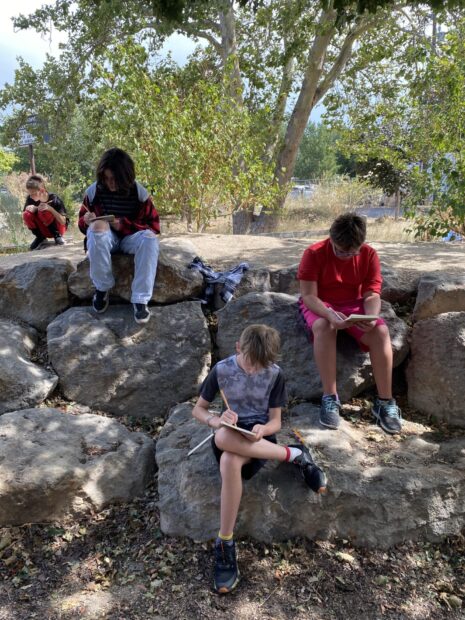
The field trips were part of a pilot program and three schools participated. This year, the program will expand to another six schools.
“The district is trying to slowly grow every year until all sixth graders in the district can participate,” Smith said.
The Boise School District used to take students to University of Idaho’s McCall Outdoor Science School for similar programming, but not every school could go due to the expenses of overnight travel. Smith said they wanted to create more equitable access to environmental learning, so the district decided to build its own homegrown program.
The more kids who get access to outdoor learning, the better, Smith said.

“There’s a huge mental health and learning benefit just getting outside, just the fresh air and being able to explore and get dirty and ask questions.”
And Smith is part of a team that’s working to expand environmental learning opportunities to schools and districts beyond the treasure valley.
A new grant program aims to support environmental education programs across the state
Smith is on the board of the Idaho Environmental Education Association, a nonprofit that aims to support teachers “working to clarify our understanding of the natural world and our role in it.”
This fall, the organization is launching a grant program to fund efforts to do just that. The awards are for up to $500, and anyone (whether they are a formal classroom teacher or not) who is providing environmental education is eligible to apply. IdEEA is based in Boise, but wants to expand and help teachers throughout the state, and the grant program is one way to do that.
“We want to ensure (students) have a love for the outdoors so as an adult they care about the issues with our environment, and care about taking care of it themselves,” Smith said. “We’ve got to find that balance of using the resources and enjoying them without damaging them and making it sustainable.”
Smith has been creatively incorporating environmental learning into her own curriculum for years.
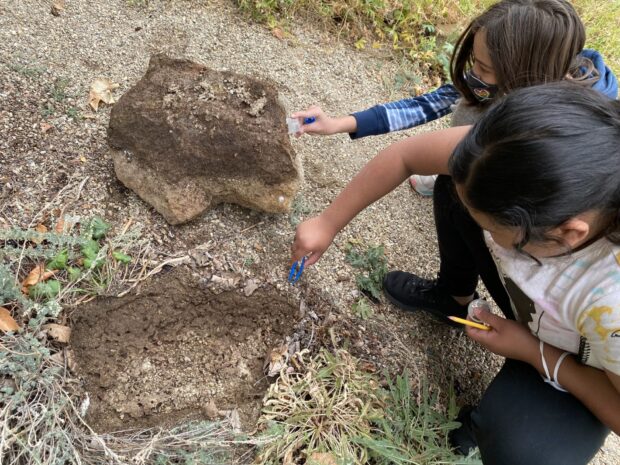
Every fall, Smith’s students choose a local environmental issue to explore throughout the school year. Past topics have included how to protect endangered and threatened species in Idaho, how to keep the Boise River free of pollution, and how to reduce single-use plastics in the Hawthorne neighborhood.
Smith then ties in math, science, English, and social studies curriculum.
She also gets kids involved with the community; for example, a past class worked with Dutch Bros. Coffee to stop offering straws and got the local Albertsons grocery store to offer paper bags along with plastics.
And she brings the community into the classroom by inviting guest speakers to discuss related topics.
“It’s always exciting to see where the kids will take it,” she said. “Even though they’re sixth graders, by the end of the year they feel empowered to make a difference in the world.”
Outdoor education has its tradeoffs
But nontraditional approaches to learning means some traditional school aspects are sacrificed.
For example, outdoor-focused schools might offer opportunities to climb or ski, but might not have traditional sports teams, like football, volleyball, or basketball. Or a school might offer a weeklong backpacking trip, but may not have school dances.
Transportation is another factor — private schools may not offer free busing for kids. And costs can be prohibitive at those schools, even when scholarships are offered.
These schools and learning models aren’t for everyone. But growing programs and increased enrollments indicate that more and more Idahoans are choosing them.
